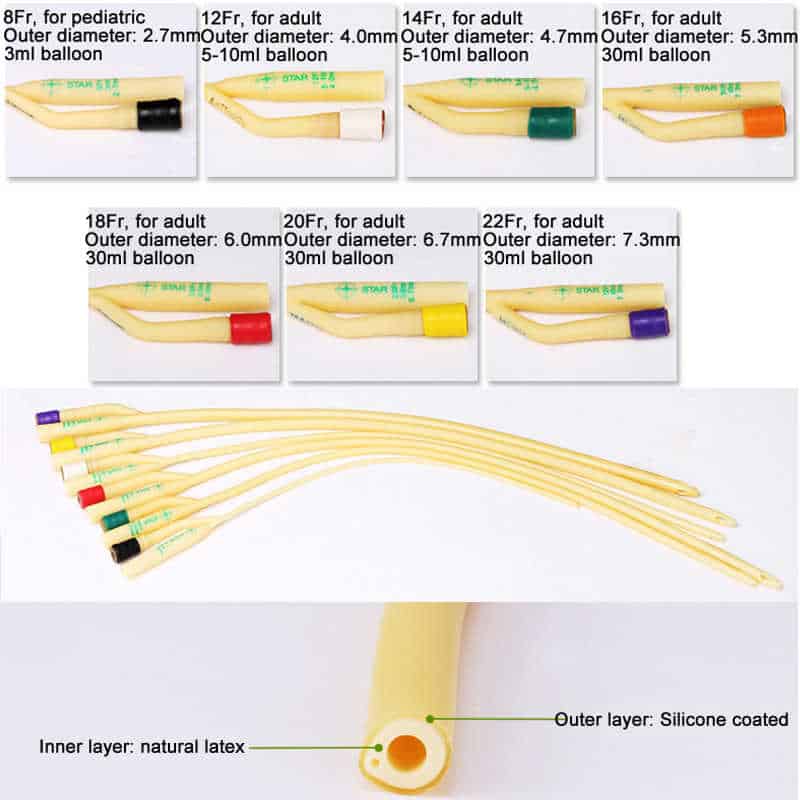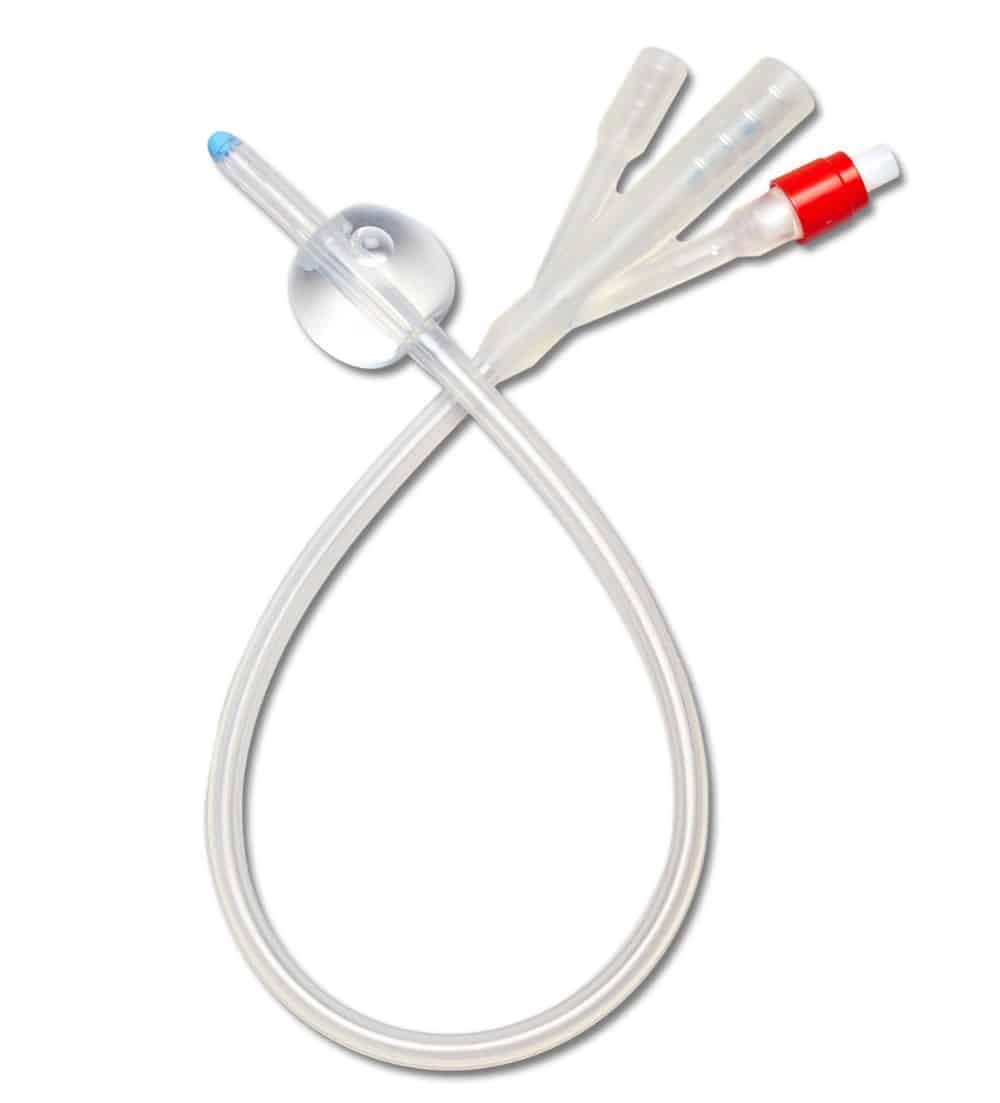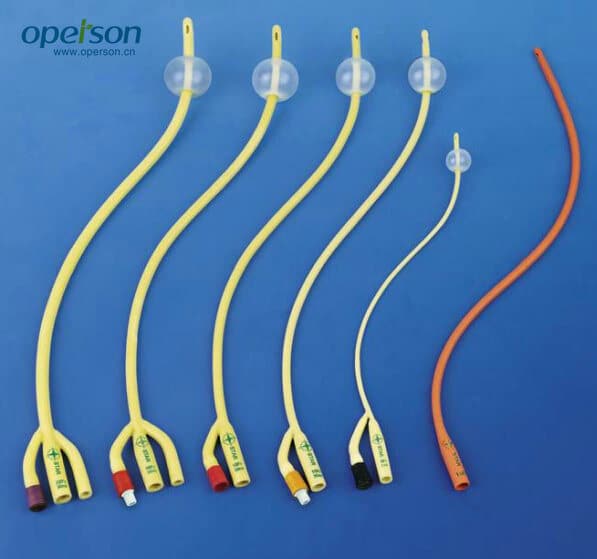Shape And Design Variations
The distal end of most urinary catheters contains two ports . One is a funnel shaped drainage channel to allow efflux of urine once the catheter is placed and the other is the inflation/deflation channel for infusion of water into the retention balloon. The infusion port for the balloon is usually labeled with the size of the balloon and the size of the catheter. Three-way catheters are available with a third channel to facilitate continuous bladder irrigation or for instillation of medication. This catheter is primarily used following urological surgery or in case of bleeding from a bladder or prostate tumor and the bladder may need continuous or intermittent irrigation to clear blood clots or debris.
The catheter should have a smooth surface with two drainage eyes at the tip that allow for urine drainage.Drainage eyes are placed either laterally or opposed. Opposing drainage eyes generally facilitate better drainage.Catheter products have changed significantly in their composition, texture, and durability since the 1990s.The challenge is to produce a catheter that matches as closely as possible to the normal physiological and mechanical characteristics of the voiding system, specifically the urethra and bladder. Foley catheters come in several subtypes, which are described in the area designs.
Which Catheter To Use
Intermittent catheterization is the preferable method to empty the bladder when you cant urinate naturally. It is safe in the short-, mid- and long-term, minimizing common risks such as urinary tract infections , strictures, bladder stone complications and upper urinary tract deterioration.
Intermittent catheterization is closest to natural urination, and gives the user control and freedom. For short-term users, intermittent catheterization gives a faster recovery and return to normal voiding after surgery.Of the different types of intermittent catheters, evidence shows that hydrophilic single use catheters are best at reducing the risk of complications.
Follow us on:
Other Types Of Male Catheters
Another type of male catheter is a suprapubic catheter. A suprapubic catheter drains urine from your bladder. It is inserted into your bladder through a small hole in your belly. You may need a catheter because you have urinary incontinence , urinary retention , surgery that made a catheter necessary, or another health problem. The catheter will make it easier for you to drain your bladder and avoid infections. Your health care provider will change the catheter for you for the first time.
Recommended Reading: Causes Of Men’s Urinary Tract Infection
What Type Of Catheter Is Right For Me
The decision about what type and size of intermittent catheters to use should be made with your prescribing physician after a thorough assessment of your medical condition and needs.
At 180 Medical, we understand that talking about personal issues like the need for catheters may sometimes feel embarrassing. When you call us, we will treat you with the respect and compassion you deserve.
Also, we recognize that you are a unique individual with unique needs. Our catheter experts will take all of that into consideration while working to tailor your catheter supply order based on your doctors prescription, your insurance plans coverage, and your preferences.
Together, we can find the right catheter from one of the many brands we carry.
How Do Catheters Stay In

Once an indwelling catheter is inserted into the bladder, an area near the end of the catheter can be inflated with sterile water, like a balloon. This small balloon is much bigger than the urethra so it holds the catheter in place, preventing it from slipping out and still allowing urine to drain through the tube in the middle of the balloon. The balloon can be deflated when the catheter is removed. Keep in mind, not all catheters stay in. Intermittent catheters are inserted only when the bladder is full, quickly draining the bladder and then removed when the bladder has emptied.
Recommended Reading: How To Treat Urinary Tract Infection Naturally
Types Of Catheters: Catheters 101
Are you new to using catheters, or do you know someone who is? The idea of catheterization may seem strange at first, but it wont take long before it becomes a very normal part of everyday life. For those who are new to the terminology of catheters, we have provided some answers to frequently asked questions in this introductory article.
What Are Catheters Used For
Catheters are medical devices that are usually inserted into a part of the body, which could be a bodily cavity, part of the skin, a blood vessel, a piece of adipose tissue, or a duct. They offer a wide range of functions, including drainage, the administration of fluids into the body, facilitating the access of medical or surgical instruments into the body, and more. Some catheters may be used for draining urine from the bladder, while others will be used to administer IV fluids into the bloodstream.
You May Like: What Medicine Is Prescribed For A Urinary Tract Infection
Do You Always Get A Catheter During Surgery
A patient who has been anesthetized with general anesthesia is unable to urinate properly. Because of this, the surgical team will place a catheter with a Foley valve prior to the procedure. The goal of this procedure is to ensure that the bladder remains empty and that the procedure is sterile and clean.
It is common for surgery to use urinary catheters because bladder control cannot be controlled under anesthesia. If you put this thin tube into your bladder while you sleep, it will help to flush the urine out. A foley catheter is used to keep the bladder empty during surgery and is commonly placed before surgery. Patients are usually guided to the operating room by catheters after surgery. When you dont self-catheterize, you leave urine in your bladder for an extended period of time. It is possible to perform hip and knee replacement surgery with no need for a urinary catheter. In the event of an anesthetic withdrawal, we ask you to go to the bathroom on your own before coming in. Laparoscopy, or open access to the abdomen, is a type of surgical procedure. It is estimated that the four-day surgery was the longest in the world.
Do You Need A Catheter For Surgery
If you are having surgery, the chances are that you will need a catheter. This is because during surgery you will be unable to empty your bladder on your own. The catheter is a small, flexible tube that is inserted through the urethra and into the bladder. Once the catheter is in place, urine can drain out of the bladder and into a bag.
A foley catheter is a silicone tube inserted into the bladder to measure urine output. It serves a much more important purpose, in addition to a broader function, in surgery. Liposuction results in the removal of a lot of fluid . If you remove too much fat too quickly, the patient may become dehydrated. The amount of fluid you require is determined by your body. Drinking too much, as long as your body does not require it, is a waste of time. When liposuction is performed, there is a limited supply of fluid available for urination. Your anesthesiologist will be able to tell if you are dehydrated after this.
Don’t Miss: How Do You Prevent Urinary Tract Infections
What Is A Urinary Catheter Used For
A urinary catheter is a hollow, partially flexible tube inserted into the bladder through the genital opening. Its purpose is to collect or drain urine into a bag attached at the other end of the tube.
Individuals may need urinary catheters for short-term or long-term use. Most individuals will only need the catheter temporarily until the condition affecting your bladder resolves. However, there are also instances that require long-term catheter use.
Here are some of the common reasons why you may need a urinary catheter insertion.
Alternative Types Of Male Catheters
There are two other male catheter options, depending on your condition and needs. 180 Medical provides these catheter types when prescribed in addition to intermittent catheters.
Indwelling Foley Catheters
Indwelling Foley catheters are mainly for long-term use. A doctor or nurse will handle inserting the catheter for you. To keep it from slipping out, they inflate a small balloon near the insertion tip to hold it in place in the bladder. Next, the Foley catheter allows urine to drain throughout the day into an attached collection device like a urinal, leg bag, or drain bag.
Since Foley catheters remain inside the body for long periods, the risk of urinary tract infections may increase. However, indwelling catheters may be the right choice for people who are unable to self-cath.
Male External Catheters
Men who use condom catheters usually wear one for no longer than a day or two at a time. Maintaining proper hygiene and changing your external catheters regularly will help minimize the possible risk of skin irritation or infections.
Recommended Reading: Royal Canin Urinary So Calm Feline
Why Urinary Catheters Are Used
A urinary catheter is usually used in people who have difficulty passing urine naturally. It can also be used to empty the bladder before or after surgery and to help perform certain tests. Specific reasons include:
- to allow urine to drain if you have an obstruction in the tube that carries urine out of the bladder for example, because of scarring or prostate enlargement
- to allow you to urinate if you have bladder weakness or nerve damage which affects your ability to pee
- to drain your bladder during childbirth, if you have an epidural anaesthetic
- to drain your bladder before, during and/or after some types of surgery, such as operations on the womb, ovaries or bowels
- to deliver medication directly into the bladder, such as during chemotherapy for bladder cancer
- as a treatment for urinary incontinence when other types of treatment havent worked
The catheter will be used until its no longer needed. This may be for a short time and will be removed before leaving hospital, or it may be needed for longer or even permanently.
Where Can I Buy Catheters From These Top Brands

If youre interested in purchasing catheters from the best brands in the business, like B Braun, Covidien, and Axiom Medical, CIA Medical is the place to be. As one of the leading providers of wholesale medical supplies and equipment, we have a vast range of top quality catheters in all of their different forms and sizes. From urinary catheters to dialysis catheters and more, you can find all you need at CIA Medical, with the best prices and industry-leading service.
Read Also: What Medications Are Used To Treat Urinary Tract Infections
Slide 1: Securing Drainage Bag
- Advance tubing another 3-5 cm once you see urine in the tubing
- Inflate balloon with 10 cc sterile water
Slide : Indwelling Urinary Catheters1
Images: Figure l. Routes of entry of uropathogens to catheterized urinary tract.An image depicts the male and female lower urinary tract system, and the difference in placement of a catheter in the bladder.
Source: Maki DG, Tambyah PA. Engineering out the risk of infection with urinary catheters. Emerg Infect Dis. 2001 Mar-Apr 7:342-7.*CMS, State Operations Manual, 2014.
1. Maki DG, Tambyah PA. Engineering out the risk for infection with urinary catheters. Emerg Infect Dis. 2001 7:342-7. PMID: 11294737.
Recommended Reading: Exercises To Improve Urinary Incontinence
Male Catheter French Sizes
Male length catheters come in many different French sizes to suit a wide variety of anatomies. What are French sizes? French size measurement is the way catheter tube diameters are sized.
Most male catheters, with the exception of certain red rubber catheters, follow the universal color-coding system, which helps you easily identify the French size of your intermittent catheter.
How do you know which French size will work best for you? Your urologist or another prescribing medical professional will be the one to help you determine the right French size to fit your unique anatomy.
For instance, if you use a smaller French size than needed, you may end up with a mess on your hands as urine seeps around the sides of the tube. Also, it will drain much more slowly.
On the other hand, a larger French size than necessary may make catheterization feel uncomfortable or even painful.
The right French size for your anatomy will drain efficiently while keeping catheterization comfortable. So be sure to discuss your catheter size options with your healthcare professional.
Slide : Alternative Catheter Types
Straight Catheters
- Inserted directly into the urethra and bladder.
- Removed after insertion and drainage of bladder.
- Used intermittently.
- Placed surgically directly through skin into the bladder.
- Connected by tubing to a bag used to collect and measure urine.
External “Condom” Catheters for Men
- Does not enter the bladder.
- Connected by tubing used to collect and measure urine output.
- Cannot be used to treat acute urinary retention.
You May Like: How Serious Is A Urinary Tract Infection
Male Closed System Catheters
A closed system catheter, which is also known as a touchless or no-touch catheter, features a pre-lubricated or hydrophilic male length catheter housed in its own self-contained sterile collection bag. This makes it great for traveling. Also, people in wheelchairs often prefer closed system catheter kits because they dont have to transfer to a toilet or find a receptacle to drain into. With a closed system catheter, you can self-catheterize anywhere you have privacy.
One new and popular option is the Hollister VaPro Plus Touch-Free Male Catheter, which has its own integrated collection bag and a protective touch-free sleeve.
Sometimes closed system catheter kits have catheter insertion supplies such as gloves, an underpad, and an antiseptic wipe. Most closed systems also feature soft pre-lubricated introducer tips to further reduce the risk of bacterial contamination.
Do You Need A Catheter For Meniscus Surgery
A catheter is not typically needed for meniscus surgery, but there are some exceptions. If you have a history of urinary tract infections or if your surgery is particularly complex, your doctor may recommend using a catheter. In most cases, the catheter is only needed for a day or two after surgery.
You May Like: Natural Remedy To Relax Urinary Tract Muscles
Are Male Closed System Catheters Covered By My Insurance
Its possible! Contact our insurance experts to get started and find out what your health insurance plan will cover for your catheterization needs.
Want to know whether your health insurance plan covers advanced catheter options like male length closed system catheters or male hydrophilic catheters? Reach out to 180 Medical to get started!
At 180 Medical, we specialize in intermittent catheters, and we carry all the major catheter brands and types, including pocket catheters for men .
When you choose 180 Medical, you have the option to try free male catheter samples that might work best for you from a wide variety of brands.
What Are Some Of The Risks Or Potential Complications Involved With Wearing A Catheter

There are a few risks and complications associated with wearing a urinary catheter. These are:
Urinary tract infection
Blood in the urine
Damage to the urethra
Damage to the kidneys
If you have any questions regarding urinary issues or problems with your bladder, urinary catheters, or urinary diversion, or would like to book an appointment, please dont hesitate to give us a call.
Also Check: What Is Azo For Urinary Tract Infections
Slide 1: Female Catheter Insertion Procedure
- Using gloved nondominant hand, identify urethra by spreading the labia
- Spread inner labia slightly with gentle traction and pull upwards toward resident’s head.
- Clean periurethral area and urethral opening using antiseptic soaked swabs using tongs, in expanding circular motion. Discard used swabs away from sterile field.
External Or Condom Catheters
Finally, we have the external or condom catheters for men who experience urinary incontinence.
Unlike the two previous types weve discussed, an external catheter doesnt have a tube that goes into the bladder. Instead, the man wears a condom-like device with a tube attached to the tip. The tube is then connected to a drainage bag that can be secured to the leg. Whenever the man experiences urine leakage due to incontinence, the urine will flow through the tube and into the bag.
You May Like: Why Am I Having Urinary Incontinence
Male Catheter Insertion Tips: Straight And Coud Tips
Next, you should know a little bit about the different types of catheter insertion tips available on all types of male catheters.
On average, most people tend to use the standard straight catheter tip. This is usually slightly tapered to aid in a more comfortable insertion, but straight catheters have no curve or bend in the tip.
Coudé tip catheters, however, feature a curve in the tip. In fact, coudé is a French word for elbow or bend. Some people may refer to coudé tip catheters as bent tip catheters or curved tip catheters.
Because some men have difficulty passing straight catheters, doctors may sometimes prescribe coudé catheters. The unique curve near the insertion tip of male coudé catheters helps aid catheter users to bypass tight places like urethral strictures, enlarged prostates, or blockages in the urethral passage.
Learn more about the basics of coudé catheters here, including the different types of coudé catheter tips.
Buying The Right Female Catheter
Female intermittent catheters allow you to control your bladder without needing a catheter permanently in your bladder. Self-catheterization also keeps the bladder from stretching and lowers the chances of infection.
Whether you prefer the classic straight or pre-lubricated version, Express Medical Supply offers the widest variety of female catheters and medical supplies. Find the products that suit you best and have them quickly and discreetly delivered to your doorstep.
Learn more about the different types of catheters and self-cathing accessories in our blog!
You May Like: Best Med For Urinary Tract Infection